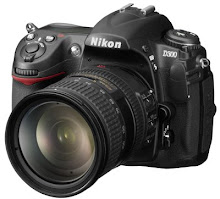Nikon D300 (Body) Digital SLR Camera
12.3 Megapixel , high-performance package
Nikon Corporation is pleased to announce the introduction of the new DX-format digital SLR, Nikon D300.
Combining innovative Nikon technologies with advanced new features and precision engineering, the D300 delivers the ultimate blend of DX-format performance.
The sheer imaging power of a new 12.3 effective-megapixel DX Format CMOS image sensor with integrated A/D converter; the precision processing and astounding speed of Nikon's original EXPEED digital image processing concept; the unprecedented focusing speed and precision of a new 51-point AF system; Nikon's innovative new Scene Recognition System for optimal autofocus, auto exposure and auto white balance performance; the composition and focusing ease of a large new pentaprism viewfinder that provides full 100% frame coverage; an expansive 920,000-dot, high-resolution 3-inch LCD monitor with wide viewing angle; near-instant power-up and immediate response; all with the advantages of Nikon DX-format agility and system expandability. Meet the new generation digital SLR camera that blends all these advanced features into one fine package – the Nikon D300.
Major Features of the Nikon D300 (Body)
New DX-format CMOS image sensor
with 12.3 effective megapixels:
The D300 features a new 12.3 effective megapixel DX-format CMOS image sensor. It not only produces fine details with sharp resolution, but also provides a broad light sensitivity range of ISO 200 to ISO 3200, (plus LO 1 for IS0 100 equivalent and HI 1 for IS0 6400 equivalent settings; Auto ISO control is also available). The CMOS sensor's integrated A/D converter features the ability to select between 12-bit and 14-bit conversion, making it possible to shoot using high-quality 14-bit NEF (RAW) format. All internal processing is handled in full 16-bit color, color, benefiting from a fine balance between performance with outstanding speed that defies this level of precision and natural-looking images that benefit from faithful color and tone reproduction. Lateral chromatic aberration is also reduced.
EXPEED – Nikon’s image processing concept embodied:
As Nikon’s new digital image-processing concept – featuring the core ideas of our image creation and processing – EXPEED incorporates the optimized knowhow and technologies we have accumulated throughout our long history while receiving users’ requirements. It realizes diversified functions to ensure high picture quality and high-speed image processing.
High-speed continuous shooting:
The D300 is capable of shooting at a rapid 6 fps*1, and as fast as 8 fps*2 when using the Multi-Power Battery Pack MB-D10, in continuous bursts of up to 100 shots*3 at full 12.3 megapixel resolution. The Nikon D300 is also the first digital SLR to support next-generation high-speed card UDMA, which enables high speed recording.
*1 When using one EN-EL3e battery installed in the camera
*2 When using batteries other than Rechargeable Li-ion Battery EN-EL3e
*3 NORMAL – LARGE image setting, using a SanDisk Extreme IV CompactFlash 1GB card
Immediate response:
Near-instant power-up within 0.13 seconds, a shutter release time lag of a mere 0.045 seconds*, and viewfinder blackout time of approximately 0.1 seconds contribute to optimized all-around performance that lets photographers respond to any sudden shutter opportunities.
* When shooting in JPEG, TIFF, or 12-bit NEF (RAW) formats
Scene Recognition System:
By improving the 1,005-pixel RGB sensor, which was first incorporated in the Nikon F5, information from the sensor can be utilized for auto exposure, auto white balance and autofocus. For example, 3D tracking in AF realized by using the Scene Recognition System tracks subject position, and automatically shifts AF points to be used according to the subject’s movement within the frame. This system also contributes to improved accuracy of auto exposure and auto white balance.
AF system employing high-density 51-point AF:
Multi-CAM 3500DX autofocus sensor module featuring 51 AF points is incorporated. 15 cross-type sensors located in the center provide subject detection capability with lens apertures as small as f/5.6. 51 AF points can be utilized in various focus area modes selected according to subject condition. In many aspects, the functions of AF points are linked with the Scene Recognition System to offer superior subject detection and focus tracking performance.
A single AF point can be selected from 51 or 11 focus points. Dynamic AF mode enables appropriate focusing by detecting subjects with a zone containing many AF points located densely. In this mode, the number of AF areas, including user selected AF points and backup points, can be selected from either 9, 21 or 51. In addition, newly employed “3D tracking” mode shifts the focus point automatically to respond to the subject’s movements. Auto-area AF mode gives greater priority to the subject’s position in selecting AF points.
Picture Control System:
Picture Control System is a new function to enable selection and adjustment to create pictures easily according to skills of users from novices to professionals. When settings are the same, even with different cameras, you can get the same picture tone. Picture Control System offers four fundamental setting options – Standard, Neutral, Vivid and Monochrome – enabling image parameters (sharpening, tone compensation, brightness, tone and saturation) to be easily adjusted and customized.
Two Live view modes available:
Live view function enables shooting while confirming subjects in the LCD monitor. In Handheld mode, which allows recomposing of the frame prior to actual shooting, ordinary TTL phase-difference AF using all 51 AF points including 15 cross-type points is activated. Tripod mode is designed for precise focus accuracy with still subjects and tripod stabilization. In this mode, focal-plane contrast AF on a desired point within a specific area is possible. Remote view, focusing and shooting are also made possible on a PC (wired or wirelessly).
Friday, August 7, 2009
Subscribe to:
Post Comments (Atom)







No comments:
Post a Comment